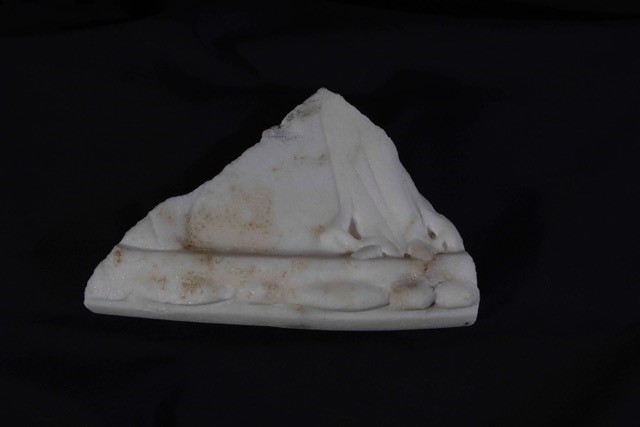Title
Triangular fragment of relief slab
Content
I.D. no: 48915
Dimensions: L. (curved side) 14 cm.; Max. L. (left side) 12 cm.; L. (right side)11 cm.; Th. 2.5 cm.
Material: Medium-grain white marble with occasional grey streaks.
Provenance: Extension of Domus Romana excavations of 1922-23.
Current location: Domvs Romana Museum in Rabat, Malta.
Condition:
The surviving triangular segment of a circular marble slab shows broken edges on two sides, the third side preserving the original faintly curved edge. Patches of dark grime, visible in pre-1984 photos, have been removed leaving behind light stains on the marble surface.
Description:
A segment from a thin slab of marble with a slightly perceptible curvature. It was decorated with a scene carved in low relief on one side and plain on the opposite side. The decorated side was framed by a band along the edge, with a projecting moulding of alternating long and short beads. Within the frame one can make out the lower legs and feet of a slim draped, probably female, figure leaning to its right. In front of it is part of an undetermined object shown in relief. The plasticity of the drapery is summarily highlighted by a series of eight tiny drilled holes.
Discussion:
Given the albeit slight curvature of the decorated edge, this fragment is likely to have formed part of the edge of a large circular marble disk, like an oscillum, intended to be hung vertically, or inserted in some circular space in a wall; or else supported horizontally like a table top,[1] or a louterion top. With regard to the latter two possibilities, both would normally require a smooth plain upper surface, rather than a plastically decorated one, for various reasons, mainly cleanliness. A search for table tops with relief decoration, in fact, proved fruitless. Archaeological literature, like Moss’ extensive thesis on Roman marble tables,[2] seems to concentrate on the decorative parts of such tables, like the supporting legs, giving much lesser attention to the upper top surface, precisely because it is plain and undecorated.
On the other hand, louteria, as well as fountain basins, require a concave hollow, even if a slight one, in the top surface, for which there is no indication in our fragment.
The alternative identification suggested above (that of an oscillum) seems to be the more plausible one, at least for the present, except for the relief decoration being limited to one side, and the sheer size of its estimated diameter based on the curvature of the fragment, which places it far beyond the normal size of around 30 cm.[3] Even if the original shape was not a full disc, but that of a crescent (or pelta), of which there are many examples, the size can hardly be reconciled with the normal standard. As far as the decoration along the rim is concerned, only one fragment of a pelta-shaped oscillum has been identified to be decorated by a row of tightly fitted small beads.[4]
In terms of typology this fragmentary object, therefore, cannot yet be claimed to have been properly classified and awaits a more specific attribution.
The little that survives of the draped figure, on the other hand, suggests a cursory style limited to broad, minimalist treatment of the drapery, resorting to expeditious small drilled holes to highlight its outspreading folds at the level of the feet. A good piece of spontaneous artisanal production that would fit well in the first century AD.
Bibliography: (previous publications of item): Zammit 1924: 6; see also Zammit Fieldnotes sketch dated 22.9.1922.
[1] Suggested to the present writer by John Hayes during one of his visits in Malta in 1984.
[2] Moss 1988.
[3] See the hundreds of examples of oscilla from different parts of the Roman west listed (and selected ones illustrated) in Bacchetta 2006, and the one from Gozo discussed in this Catalogue (ID no. 100897).
[4] Bacchetta 2006: 537, pl. 43,2.



